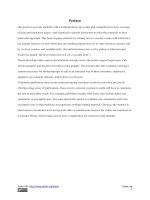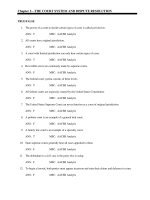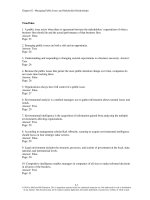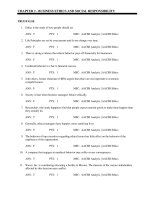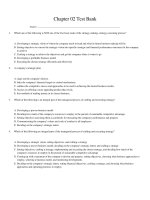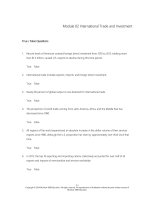Andersons business law and the legal environment comprehensive volume 22nd edition twomey test bank
Bạn đang xem bản rút gọn của tài liệu. Xem và tải ngay bản đầy đủ của tài liệu tại đây (218.34 KB, 7 trang )
Chapter 2—THE COURT SYSTEM AND DISPUTE RESOLUTION
TRUE/FALSE
1. The power of a court to decide certain types of cases is called jurisdiction.
ANS: T
MSC: AACSB Analytic
2. All courts have original jurisdiction.
ANS: F
MSC: AACSB Analytic
3. A court with limited jurisdiction can only hear certain types of cases.
ANS: T
MSC: AACSB Analytic
4. Reversible errors are commonly made by supreme courts.
ANS: F
MSC: AACSB Analytic
5. The federal court system consists of three levels.
ANS: T
MSC: AACSB Analytic
6. All federal courts are expressly created by the United States Constitution.
ANS: F
MSC: AACSB Analytic
7. The United States Supreme Court can never function as a court of original jurisdiction.
ANS: F
MSC: AACSB Analytic
8. A probate court is an example of a general trial court.
ANS: F
MSC: AACSB Analytic
9. A family law court is an example of a specialty court.
ANS: T
MSC: AACSB Analytic
10. State supreme courts generally hear all cases appealed to them.
ANS: F
MSC: AACSB Analytic
11. The defendant in a civil case is the party who is suing.
ANS: F
MSC: AACSB Analytic
12. To begin a lawsuit, both parties must appear in person and state their claims and defenses in court.
ANS: F
MSC: AACSB Analytic
13. If questions of fact are involved, the court will decide the case based on the pleadings alone.
ANS: F
MSC: AACSB Analytic
14. Documents filed by both parties at the beginning of a lawsuit are called the pleadings.
ANS: T
MSC: AACSB Analytic
15. Depositions are usually taken in the courtroom.
ANS: F
MSC: AACSB Analytic
16. A peremptory challenge to a prospective juror generally can be exercised without giving a reason.
ANS: T
MSC: AACSB Analytic
17. A motion for a directed verdict occurs immediately after the last pleading is filed.
ANS: F
MSC: AACSB Analytic
18. Once a lawsuit is commenced, the case must go to the jury.
ANS: F
MSC: AACSB Analytic
19. Generally, the prevailing party in a lawsuit will be awarded the costs of the action, including witness
fees and jury fees.
ANS: T
MSC: AACSB Analytic
20. Garnishment is a procedure accomplished only by attorneys.
ANS: F
MSC: AACSB Analytic
21. Mediation is a generally accepted method of resolving disputes.
ANS: T
MSC: AACSB Analytic
22. Arbitration procedures occur in a court of law.
ANS: F
MSC: AACSB Analytic
23. The Uniform Arbitration Act requires a written agreement to arbitrate an issue.
ANS: T
MSC: AACSB Analytic
24. When arbitration is mandatory under a statute, the losing party generally can appeal from such
arbitration to a court.
ANS: T
MSC: AACSB Analytic
25. A mediator has the power to actually make a decision in a dispute.
ANS: F
MSC: AACSB Analytic
26. Mediation tends to keep discussions between parties proceeding.
ANS: T
MSC: AACSB Analytic
27. If there is a reference to a third party to determine a dispute, in most cases the decision is binding.
ANS: T
MSC: AACSB Analytic
28. A "rent-a-judge" serves as a referee.
ANS: T
MSC: AACSB Analytic
29. The decision of an association tribunal is binding on both the association member and the consumer.
ANS: F
MSC: AACSB Analytic
30. Provisions in contracts may actually prevent future lawsuits from occurring.
ANS: T
MSC: AACSB Analytic
MULTIPLE CHOICE
1. A court is a tribunal established by:
a. the parties to a lawsuit.
b. the government.
c. the parties to a contract.
d. none of the above.
ANS: B
MSC: AACSB Analytic
2. The power given to courts to hear certain types of cases is called:
a. jurisdiction.
b. mediation.
c. arbitration.
d. summary judgment.
ANS: A
MSC: AACSB Analytic
3. Original jurisdiction courts are generally ____________.
a. supreme courts
b. appellate courts
c. trial courts
d. limited courts
ANS: C
MSC: AACSB Analytic
4. Which of the following is an example of limited or special jurisdiction court?
a. Probate court
b. Juvenile court
c. Domestic Relations court
d. All of the above.
ANS: D
MSC: AACSB Analytic
5. The federal court system consists of ____ level(s) of courts.
a. one
b. two
c. three
d. four
ANS: C
MSC: AACSB Analytic
6. The types of civil cases that can be brought in federal district courts include:
a. cases in which any state in the United States is one of the parties .
b. cases between citizens of different states that involve damages of $75,000 or more.
c. cases brought by the citizen of one state against the state government of the same state.
d. all of the above.
ANS: B
MSC: AACSB Analytic
7. The United States Supreme Court was created by:
a. Congress.
b. the President.
c. the Uniform State Law Commission.
d. none of the above.
ANS: D
MSC: AACSB Analytic
8. State supreme courts primarily have what type of jurisdiction?
a. appellate
b. limited trial court
c. general
d. none of the above
ANS: A
MSC: AACSB Analytic
9. The person who initiates a civil lawsuit is called the:
a. defendant.
b. prosecutor
c. plaintiff.
d. judge.
ANS: C
MSC: AACSB Analytic
10. Service of process refers to:
a. a demand letter sent by the plaintiff to the defendant.
b. a reply sent to the plaintiff by the defendant.
c. giving the defendant proper notice that a legal action is pending.
d. a record of the court's preliminary hearing.
ANS: C
MSC: AACSB Analytic
11. The answer to the complaint is filed by the:
a. defendant.
b. prosecutor .
c. plaintiff.
d. judge.
ANS: A
MSC: AACSB Analytic
12. When a defendant asserts that even if everything the plaintiff said is true there is no right to recovery,
the defendant is making a:
a. counterclaim.
b. motion to dismiss.
c. motion for summary judgment.
d. deposition.
ANS: B
MSC: AACSB Analytic
13. Who is entitled to file a motion to dismiss?
a. defendant only
b. plaintiff only
c. both plaintiff and defendant
d. none of the above
ANS: A
MSC: AACSB Analytic
14. A deposition:
a. is the testimony of a witness taken under oath.
b. is conducted outside of the courtroom.
c. can be used to impeach a witness.
d. all of the above.
ANS: D
MSC: AACSB Analytic
15. Voir dire examination is used in connection with:
a. determining whether the pleadings are valid.
b. jury selection.
c. deciding whether to appeal a trial court decision.
d. none of the above.
ANS: B
MSC: AACSB Analytic
16. The _____ rule(s) on the admissibility of evidence.
a. Judge
b. Jury
c. Attorneys
d. court clerk
ANS: A
MSC: AACSB Analytic
17. A motion for a directed verdict is appropriate:
a. immediately after the pleadings are filed.
b. immediately after discovery is concluded.
c. immediately after the presentation of all evidence at trial.
d. on appeal.
ANS: C
MSC: AACSB Analytic
18. One of the motions that can be made after a verdict has been entered is a motion for a:
a. mistrial.
b. summary judgment.
c. directed verdict.
d. judgment notwithstanding the verdict.
ANS: D
MSC: AACSB Analytic
19. Costs generally are awarded to the prevailing party in litigation. Those costs usually include:
a. filing fees.
b. service-of-process fees.
c. deposition transcript costs.
d. all of the above.
ANS: D
MSC: AACSB Analytic
20. Garnishment applies to the judgment debtor’s:
a. wages.
b. attorney fees.
c. land and home.
d. cars.
ANS: A
MSC: AACSB Analytic
21. Which is not considered an alternate means of dispute resolution?
a. civil lawsuit
b. arbitration
c. association tribunals
d. minitrial
ANS: A
MSC: AACSB Analytic
22. In mediation, the mediator acts as a:
a. judge.
b. attorney.
c. messenger.
d. expert witness.
ANS: C
MSC: AACSB Analytic
23. A summary jury trial is:
a. binding on the parties.
b. a mock trial.
c. a full and complete hearing of all evidence pertaining to the case.
d. a shortcut to establishing judicial precedent.
ANS: B
MSC: AACSB Analytic
24. In a minitrial:
a. only three jurors are used.
b. the trial addresses only portions of the case or certain issues related to the case.
c. the decision is always fully binding on the parties.
d. none of the above.
ANS: B
MSC: AACSB Analytic
25. Judicial Triage:
a. is a court management tool.
b. results in some cases being expedited.
c. results in some cases being postponed.
d. all of the above.
ANS: D
MSC: AACSB Analytic
CASE
1. Chandra sues Martin for breach of contract. Both parties have completed discovery. Chandra now
wants her attorney to file a motion to have the judge rule in her favor without having to proceed
further. Chandra does not know whether the motion to dismiss or the motion for a summary judgment
is proper. Which motion is proper and why?
ANS:
As between the motion to dismiss and the motion for summary judgment, Chandra’s attorney should
file a motion for summary judgment, since the parties are beyond the pleadings stage of litigation, and
since they have completed discovery. Using evidence gathered during discovery, such as affidavits
and/or deposition testimony, Chandra’s attorney could argue that there are no material issues of fact
disputed by the parties, and that Chandra is entitled to judgment as a matter of law.
MSC: AACSB Reflective Thinking | AACSB Analytic
2. Billy has a dispute with Sleepdigit Bedspring Company over a number of beds Billy recently
purchased from Sleepdigit for use in his hotel. Billy needs to decide whether to pursue litigation or
employ an alternative means of dispute resolution. What advantages are most often associated with
alternative dispute resolution? Which choice would be most appropriate in this case?
ANS:
The most frequently cited advantages of alternative dispute resolution, compared to litigation, are a)
cost savings and b) time savings. As far as a specific method of alternative dispute resolution,
arbitration might be the best approach for Billy in his commercial dispute with Sleepdigit; in addition
to the cost-saving and time-saving advantages of alternative dispute resolution, arbitration has a long
history of success in the area of commercial contracts.
MSC: AACSB Reflective Thinking | AACSB Analytic

